Planning to take TOEFL? We are here to help you enhance your skills and organize your daily study routine. Let’s figure out test format essentials and learn what earns you a high score. Whether you’re taking TOEFL iBT or TOEFL paper-delivered test, it’s critical to understand the exam’s general specific and crucial points when preparing on your own or with a tutor.
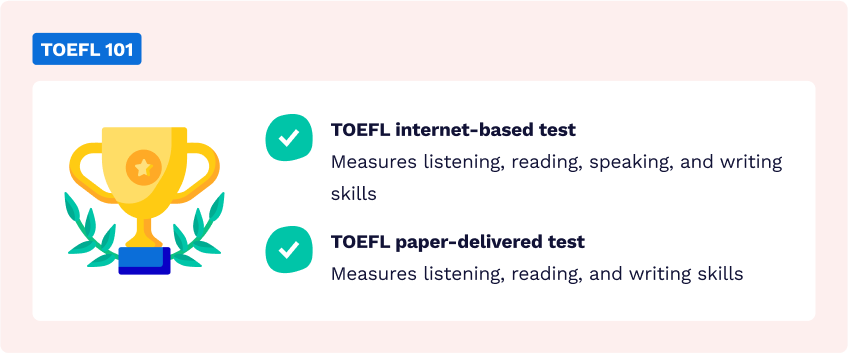
This article is the ultimate guide to everything you need to know to receive a top score and much more. Follow the pro tips from our experts to maximize your efficiency and English language skill.
Dive in!
TOEFL Sections: Short Overview
You may ask: what is TOEFL?
The Test of English as a Foreign Language (TOEFL) evaluates your English language proficiency. It estimates listening, reading, speaking, and writing skills. You can use its results for study, immigration, or work purposes. Companies and universities in 150+ countries accept the TOEFL test for admission or applying for a position.
The first major thing to clarify is the TOEFL format and timing for each section of the test. Knowing how each part is organized will help you create an efficient strategy and optimize the completion of the TOEFL tasks. Thus, during the exam, you will not feel anxious about running out of time.
TOEFL Format
It is worth noting that even if you speak fluent English, it is still necessary to study the TOEFL test structure. For instance, the Reading section may contain tricky questions, and if you aren’t familiar with them, you will lose the points. Also, this is crucial for fulfilling writing tasks. Your ideas may be correct, but you should also follow a specific outline to get the highest score.
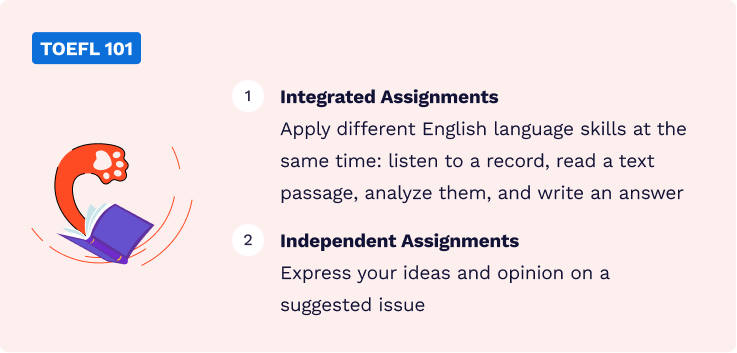
The TOEFL exam has two versions:
- The TOEFL internet-based test (IBT). This online test measures all four parameters: listening, reading, speaking, and writing. You can take it in secure test centers.
- The revised TOEFL paper-delivered test. It is available for the locations without the internet testing option. This format doesn’t include a speaking section.
Both test versions include independent and integrated assignments. In the first type of task, you will be asked to present your ideas and opinion on a suggested issue. While in the integrated one, you will apply different English language skills at the same time. For example, you should listen to a record, read a text passage, analyze it, and write an answer.
Now, when you know the background, let’s briefly look at the TOEFL test sections:
TOEFL Reading Part
The total word count of all texts in the TOEFL iBT Reading equals 700 words. This means that you may expect three or four text pieces. They are multiple-focused, e.g., compare/contrast and cause/effect. The section includes ten questions for each block. You can receive up to 30 points if you fulfill this part correctly.
The only difference between TOEFL iBT and TOEFL paper-delivered test Reading is that the second one usually contains three text passages.
TOEFL Listening Section
The module contains 3 – 4 recorded passages for the iBT and only 3 passages for the TOEFL paper-delivered test. They may also include classroom discussions that you should carefully listen to. After hearing the audio, you need to answer the questions – six per record.
The second block of the TOEFL Listening test includes 2 – 3 (IBT) or 2 (TOEFL paper-delivered test) conversations. After each of them, you will have five questions to answer. The total maximum score that you can gain for this module is also 30 points.
TOEFL Speaking Module
TOEFL iBT test Speaking part consists of four tasks that resemble the possible real-life situations where you need to apply your language skills. Let’s see what’s inside this section:
- The first assignment is called ‘independent task’ because you must share your own ideas and thoughts on a specific topic. This task focuses on expressing your point of view and supporting it with relevant facts or experiences.
- Questions 2-4 are known as ‘integrated assignments,’ meaning that you have to show how you perceive information visually or auditorily, analyze it, and give an oral answer.
For this section, the maximum number of points you can earn is also 30.
TOEFL Writing Rubric
This particular module of the TOEFL exam aims at assessing the ability to express your thoughts in writing, giving proper reasoning behind crucial statements. One of the most important requirements here is to provide concise, well-organized answers. What’s the structure of this block?
Same as in the TOEFL Speaking part, there are two types of questions:
- The integrated writing task requires reading a passage and listening to a short recording. After this, you should write your response to the given questions.
- In the independent writing assignment, you must contemplate a specific TOEFL writing topic, providing examples from your knowledge or personal experience. To familiarize yourself with the format, you may want to see what other students write. For that, check out 100% free essays from our samples database.
When will you receive the final grades?
For those taking TOEFL iBT, scores will be available online within six days after the exam date. The PDF score transcript will become available for downloading within eight days after the exam date.
Your test answers are processed by AI and ETS-certified raters – a team of professionals responsible for organizing TOEFL. While a computer checks the Reading and Listening sections, the Speaking and Writing sections require special treatment, so a team of professionals assesses them by applying advanced technologies.
If you’re taking the TOEFL paper-delivered test version, the score report will be mailed within five weeks after the exam date.
Make sure to read all the details about the exam’s scoring system on the “Understanding Your TOEFL iBT Scores” web page. Additionally, TOEFL reading score calculators or convertors will help you compare your TOEFL points with other score systems.
TOEFL Test Timing
Timing is the essential factor that affects your performance at the test. Your chances to gain an excellent TOEFL score are much higher if you’re managing the given time properly. If you don’t want to spend the last minutes of the exam in a hassle, you should train to get things done within the limitations.
For your convenience, we prepared a table with exact timing details for the TOEFL exam. Check it out!
The difference between TOEFL iBT and TOEFL paper-delivered test, in this case, is hardly noticeable. All sections have almost equal duration.
When preparing for the test at home, try to complete practice tasks within these time limitations. In the beginning, you may need more time to adjust to the question type or answer format, but as you progress, you can try to simulate the exam procedure to get ready for it mentally. This will help you avoid the rush and extra stress on the test day.
Now that you know general information about the test, let’s take a closer look at what each section suggests. We’ll also discuss the best listening, reading, speaking, and writing strategies for the TOEFL iBT and TOEFL paper-delivered test.
TOEFL Reading
The TOEFL Reading questions evaluate your reading and comprehension abilities. In this block, you will encounter the text passages that are taken from university-level books. The wide variety of subjects and disciplines to which these excerpts belong include business, production, astronomy, medicine, biology, physics, chemistry, and more. However, you shouldn’t worry that any of the topics in TOEFL Reading might be unfamiliar to you. The tasks are designed so that you can solve them without knowing the subject deeply. You only need well-developed language and comprehension skills.
To get ready for this section, let’s analyze the question types you may come across and the best strategies for completing this part.
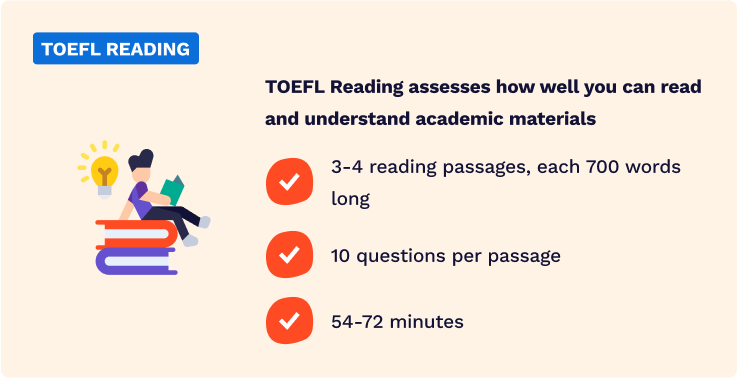
TOEFL Reading: Question Types
TOEFL iBT Reading section includes 3 – 4 text passages at about 700 words each and 10 questions per fragment. You will find the following types of tasks here:
- Reading factual information
- Inference and Rhetorical purpose
- Reading vocabulary
- Sentence simplification
- Insert text
- Prose summary and Fill in a table
The tasks may vary from test to test. However, there’s always an Insert text and Prose summary or Fill in a table task.
What’s inside each of them?
- Reading factual information
There are two kinds of such questions: Factual information and Negative factual information. The first one asks you to recognize the data declared in the text explicitly. It includes definitions, key ideas, and any supporting details. Only one answer is true and correct.
On the contrary, in the Negative factual information assignment, three of four sentences are true. Your task here is to detect the false variant. This one can be tricky, so you should be attentive. If the question contains the words NOT or EXCEPT, it is a Negative factual information one. Sometimes when you’re in a rush or too anxious about the test, you may not notice these details and, as a result, lose points.
- Inference and Rhetorical purpose
The next type of tasks can be split into Inference and Rhetorical purpose assignments. The first suggests you identify the information that is not explicitly stated in the passage. You may recognize such questions by the words ‘infer,’ ‘imply,’ or ‘suggest.’
Rhetorical purpose tasks also ask you to find the information that is not mentioned in the text. However, there’s a crucial distinctive feature: the question asks you to define why the author presented these details.
Why do you need to differentiate these types of questions?
When completing practice tests from the TOEFL Reading section, knowing such details makes the process much easier. For instance, you see a question like “Why does the author mention X?” where X is a specific idea or definition. Now, you know that this is a rhetorical purpose task, so you must find the reason. Even if it’s not written straightforwardly in the text, the reason can be marked by words like ‘because’ or ‘due to the fact,’ so you can notice it.
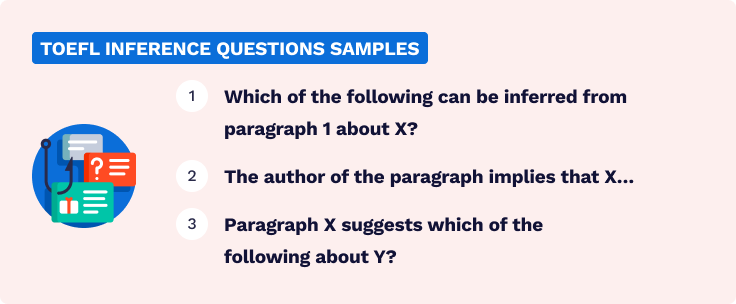
- Reading vocabulary
Vocabulary questions ask you to recognize the meanings of highlighted phrases and words. Most of the time, these words are of academic level. Contrary to similar tasks in IELTS or other exams, this test suggest that you should know these words. They belong to the essential vocabulary for TOEFL. You don’t need to play a guessing game or try to understand the meaning from the context. That’s why the best strategy is to build your vocabulary. Reading TOEFL books like Vocabulary and Grammar for the TOEFL Test would be a helpful daily practice.
- Sentence simplification
These questions from the TOEFL reading module ask you to compare the highlighted sentence with several other options and choose which meaning is the same. The correct answer restates the crucial information and idea of the highlighted sentence. However, some extra details may be missing. Your main goal here is to identify which data is essential and which is not.
Sometimes it can be challenging, but here is the best strategy to detect the crucial information. Usually, the sentence presents a vital cause/effect relationship or a conclusion based on previously mentioned evidence. You should focus on this and look for a restatement among the suggested answers.
- Insert text
In this type of question, your task is to select the best position for the sentence in the passage. The assignment evaluates your understanding of the logical order of ideas in the text. If you’re taking TOEFL iBT, you will see an excerpt with four black squares put in different places. These are the options where you can insert the suggested sentence. In the paper-based TOEFL, the test taker chooses the correct answer out of four options.
There’s an easy yet effective tip that will help you succeed in this task. Pay attention to the pronouns and learn to match them with the words in the passage that they refer to.
- Prose summary and Fill in a table
Prose summary questions contain three correct answers with the essential information and three incorrect ones. You can get up to two points for three correct answers, and each wrong choice subtracts one point.
Keep in mind that a single correct answer will not give you points at all. It is also not possible to get a negative score.
In the fill-in table questions, the test taker should divide available answers into several categories.
TOEFL Reading Strategies
We prepared a set of TOEFL reading strategies and tips. Use them to improve your academic performance and TOEFL Reading scoring. Here’s how to succeed in this section:
- Don’t rely on the same words or phrases.
Sometimes the text passage and the question contain the exact words, but this may confuse you. For instance, the phrase in the sentence may be positive, while the answer is negative. That’s why it’s better to focus on looking for synonyms instead and double-check each option. - Read academic magazines, newspapers, and study materials.
Each section of the TOEFL exam is based on educational materials you may encounter in your further studies. This is the reason why reading academic journal articles can significantly impact your exam performance. Taking notes and writing down new vocabulary each time you read something will make this activity even more fruitful. - Take concise notes during the exam.
Surely, you won’t have time to note down everything you hear or think of. Instead, try to write down only crucial details, names, definitions, and key insights. It can be a word or two, but make sure you will understand what they stand for. - Combine various study materials in your daily practice.
If you’re preparing for the test on your own, you can start by purchasing a TOEFL guide with practice tests and a theoretical explanation of each section. However, this won’t be enough if you want to score 100+ points. The best TOEFL Reading practice is to accompany the book by watching relevant YouTube channels and using a vocabulary app on your smartphone. - Exclude wrong answers if you cannot find the correct answer instantly.
Sometimes you may forget the meaning of some words, or it can be hard to understand one of the options. In this case, a helpful strategy will be to eliminate the incorrect answers. Find evidence that proves this in the text – they will lead you to a correct variant.
To make the most use of these tips, implement them as soon as possible. It isn’t hard to read one short academic article a day or play a vocabulary game while commuting to work or study. Still, this routine can turn out to be highly beneficial in the long run. And it works the same with the other strategies from our list too!
TOEFL Listening: Tips and Strategies
The TOEFL Listening section evaluates your ability to comprehend information through listening and interpret it to answer the questions. For some students, auditory perception may be more complicated than visual. This means that even if you can scan the text, it’s not guaranteed that you can understand English speakers well. Another factor that can make listening harder is the variety of accents. In TOEFL Listening, you will hear different people from North America, the U.K., New Zealand, or Australia.
To help you overcome these hurdles and get ready for this section, we prepared tricks and strategies that will be beneficial for you. But first, let’s study the structure of this part of the test.
TOEFL Listening Format and Questions
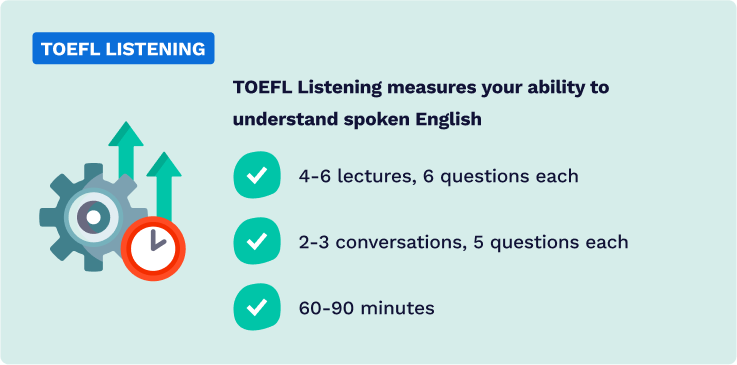
As we already mentioned, it’s essential to understand the structure of the tasks as it enables you to develop your methods of dealing with them. Knowing what to expect on the exam day also reduces your anxiety and makes you better at managing your time.
In the TOEFL Listening module, you may encounter seven types of tasks. Let’s see what’s inside each of them.
- Gist-content and Gist-purpose questions
The gist of the monologue or conversations you will hear in this section means its key idea. Gist-content questions suggest you identify the main topic of the recording, while the Gist-purpose questions ask you to detect the main aim.
In the test, you will come across either the Gist-content or Gist-purpose questions. This type of exam question can contain more than one correct answer. It’s usually mentioned in the task.
- Detail questions
The most straightforward among all task types are detail questions. They test your attentiveness and ask you to remember specific information from the recording.
Information like this is easy to miss when you focus on the general context. However, there’s something that can help you cope with this task easily. Take brief notes when listening, especially when you hear names, dates, places, time, or other small details. You don’t have to write complete sentences but at least try to write full phrases not to miss the context.
- Function Questions
This type of task is complex because it requires you to understand the conversation or a monologue at a deeper level. You have to find out the real meaning of a particular statement. Here, you should understand the difference between the surface or literal meaning and the real meaning. The first refers to what you hear the person is saying, while the second shows the actual message behind those words. Let’s analyze the example:
Surface / literal meaning:
“I have some housework to be done today, and we also have a family dinner.”
Real meaning:
“I can’t go out with you tonight.”
To get the real meaning, you should analyze the context and determine the critical point of the monologue or conversation first.
- Attitude Question
This type of task asks the student to identify someone’s feelings about something. To detect the speaker’s feelings or attitude, listen for statements that start with “What I think…” or “It seems to me…” in the recording. You will then hear how sure the speaker’s facts are or whether he believes the arguments to be valid or not.
A helpful tip on this is to listen to the speaker’s tone of voice. This can show you their attitude and feelings about the situation or specific facts. Ask yourself: is the speaker emotional or calm? Certain or not? Annoyed or enthusiastic?
- Organization Questions
In this type of task, you should show how you understand the structure of the recording. These questions focus on the examples that are provided in the lecture excerpts you hear, so make sure you listen to them and write down key points. Try to find the explanation why the speaker mentions specific details.
If it is complicated to indicate what points are worth noting, listen for the signal words that point out the introduction, major ideas, examples, and the conclusion. These can be sequence words like ‘first,’ ‘next,’ or ‘then.’ Or chronology words, like ‘before,’ ‘during,’ or ‘since.’ Words can also show cause/effect relations, like ‘accordingly’ or ‘as a result.’ These signal words will show you when to take notes.
- Connecting content Questions
In these assignments, you need to show your understanding of the relationships between different ideas or statements in the audio. Connecting content tasks may require you to fill in a table or a chart. You may be asked to do the following:
- Identify steps in a process
- Detect cause/effect relationships
- Classify items
- Make a prediction
When practicing at home, it will be beneficial for you to stop the audio at some points, make a summary of what’s been just said, and try to predict what will be said next.
- Inference Questions
Same as in the TOEFL Reading test, you will come across the tasks in which you should identify things that are not explicitly stated in the recording. These questions may be complicated because they are not as straightforward as most of the previous ones. However, there’s still a strategy that can help you deal with them.
To understand what the speaker implies, listen for words they use to support their point of view. Are those generally negative or positive? The answer will lead you to the correct choice.
TOEFL Listening Strategies
We already mentioned tips that can help you cope with different types of questions, but what are the general recommendations on improving your listening skills?
Check out the list below to understand what to focus on during your TOEFL Listening practice.
- Listen to the recording as many times as needed.
When practicing on your own, play the audio as many times as you need to understand every single detail completely. You’re not short on time, so don’t skip anything! The more you train, the fewer times you need to listen to it. - Take concise notes while listening.
The first time you may need to pause the recording to write down some details, and that’s okay. Remember that you shouldn’t note the whole sentence. A key phrase or a few essential words will be enough. - Listen for the key point first.
When you hear the recording for the first time, don’t try to comprehend everything simultaneously. Instead, start by identifying the general idea and speakers’ attitude first. Next, you can focus on more minor details. This will help you get a complete image of the situation, and you won’t miss anything. - Practice TOEFL Listening with YouTube and TV shows.
Make your study process more entertaining by watching your favorite shows or interesting programs in English. Channels like TEDx Talks will be super beneficial because you can practice listening for TOEFL with the help of the lectures on various disciplines.
Make sure you combine different preparation techniques to achieve the highest results. Also, remember to take your time and don’t be anxious about things going not as good as expected at the beginning. As you practice, it will become much more manageable.
TOEFL Speaking Section
In the TOEFL Speaking section, you need to show that you can express your perspective using relevant vocabulary and grammatical constructions. Your ability to react to the information you hear will be tested too. That’s why this exam part contains two kinds of tasks: Independent speaking assignment and Integrated speaking questions.
One of the main hurdles in this section is lacking time to compose your answer. In the TOEFL Writing module, you can evaluate and edit your composition. Here, you should make on-the-spot decisions. This may be a problem even for those who are confident in their language skills.
This block of the article will break down each TOEFL speaking question and give tips on completing them. Also, you will find general strategies that will help you in your TOEFL speaking practice.
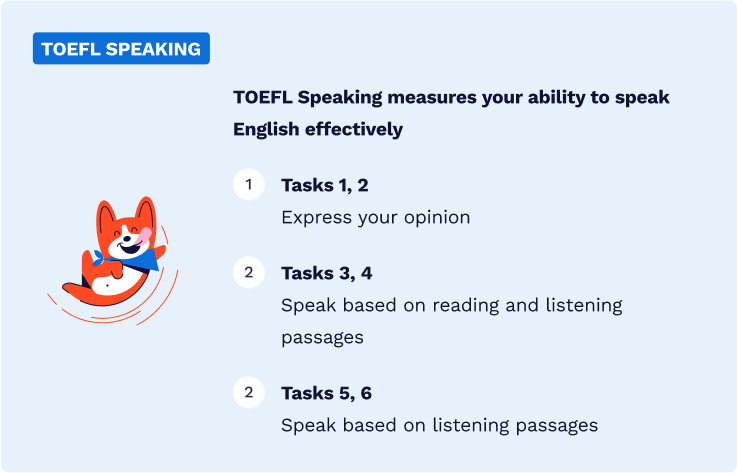
TOEFL Speaking Questions
The TOEFL speaking module contains one independent and three integrated assignments. Each consists of the preparation (15 – 30 seconds) and response (45 – 60 seconds) parts. You will use the microphone on the provided headset to record the answer.
The general structure of this exam part is as follows:
- Question 1 – Independent,
- Question 2 – Integrated,
- Questions 3 & 4 – Integrated.
Now, let’s analyze each of them in more detail.
- Question 1 – Independent
This task requires you to express your views on a specific topic. You will have up to 15 seconds to prepare and 45 seconds to respond. It may seem that you have not enough time to gather your thoughts but remember that you won’t have much more at university or college. The exam aims at simulating real-life circumstances.
Usually, in this question, you will be given opinions on a specific issue. Your task is to choose which one you prefer and provide arguments to support your choice. Here’s an example of such an assignment:
Some people think it is more fun to spend time with friends in restaurants or cafes. Others believe it is more fun to spend time with friends at home. Which do you think is better? Explain why.
As illustrated, you need to provide your opinion and relevant reasoning. Note that the test raters evaluate language delivery and use. That is why it is necessary to answer the question fully, clearly express ideas, and connect them logically.
- Question 2 – Integrated
In this type of task, you must make use of different language skills. You will receive a written piece on a campus-related topic and then listen to a conversation on the same subject. After this, you will have 30 seconds to prepare and 60 seconds to respond to the given question.
In question two, you should analyze the speaker’s opinion on the information you heard and its relation to the passage you read. Your essential task is to combine and summarize the data from these sources. After looking through the passage, listen attentively whether the speaker agrees or disagrees with the points presented in the reading.
- Question 3 & 4 – Integrated
In question three, you should read a text piece on an academic topic. After this, you will hear a part of a lecture on that same subject. You’ll be given 30 seconds to prepare your answer and 60 seconds to respond. Here, the text and the recording will always discuss a specific academic concept or term you may encounter in the first-year textbook. For instance, an excerpt on Psychology may describe what clinical depression is. The listening part of this task will present the example of this term. When answering this question, point out how the example illustrates the concept’s meaning in the text passage.
In question four, you’ll hear a part of a lecture. Then, you will have 20 seconds to prepare your answer and 60 seconds to present it. The lecture’s structure is similar to the one in the previous question: it starts with a speaker mentioning the specific concept, then he presents the examples to illustrate it. Here, your task is to summarize the lecture’s words and explain the idea by providing examples from the lecture.
TOEFL Speaking Tips
Now, let’s see the most effective tips for making your TOEFL Speaking practice more fruitful. Our recommendations include general advice and specific strategies that will help you enhance certain skills needed to successfully fulfill the Independent and Integrated tasks.
Let’s see what they are!
- Don’t write and memorize ready answers.
You can find many TOEFL Speaking topic lists and answer samples on the Internet, and it’s helpful to analyze them. However, never try to memorize them. Firstly, because they may turn out to be irrelevant for the actual exam question. Secondly, because it won’t help you develop speaking skills and your perspective, you will memorize somebody’s ideas. - Write down key words during preparation time.
You won’t have time to compose the complete answer during the exam, so the best way to organize your thoughts is to note down crucial words or phrases and develop your ideas based on them. - Practice English with native speakers.
You don’t necessarily need to attend the local speaking club for that. There’re plenty of platforms to communicate with native speakers on the Internet, and you can also do that when playing multiplayer games online. - Practice continuous speaking.
When preparing for this section, set a stopwatch and speak on a specific issue for at least 45 seconds. This may be challenging at first, but this will become an easy task for you as your train. - Record your answers.
A highly beneficial routine is to record your response when practicing at home. Then, you can listen to it, highlight the mistakes or things to improve, and work on them. - Don’t be anxious about not knowing something.
It’s impossible to predict what TOEFL Speaking topics you will get. However, you shouldn’t be afraid of this. You should be able to analyze the content and see its key points.
We hope that’s these tips will help you succeed in the Speaking section and avoid mistakes that keep students away from receiving high scores.
TOEFL Writing Section
The Writing Section measures your ability to express your thoughts in written form. It’s similar to the Speaking part in terms of creativeness. The best answers here should also be concise and well-structured. This format also allows you to edit your response, so it’s a bit easier than speaking.
In this section, you will deal with two writing assignments: Integrated task and Independent task. Your response will be evaluated by the ETS raters and AI.
The answers shouldn’t be very long, and there’s enough time to complete and proofread them before submitting. You can find free TOEFL Writing templates to get inspiration and essential guides for your preparation.
Now, let’s take a closer look at the tasks.
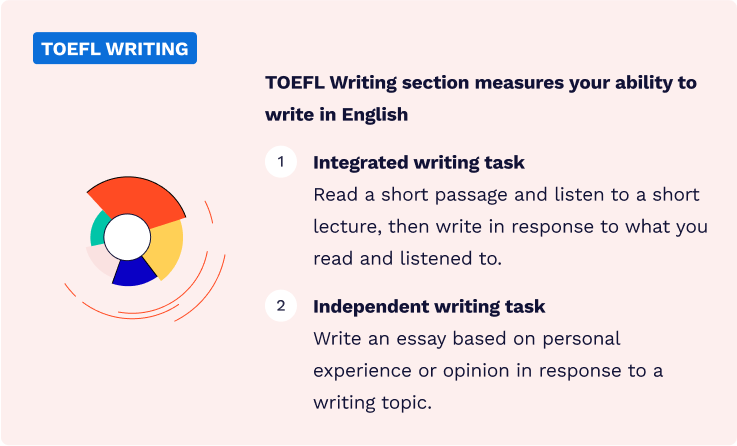
TOEFL Writing Structure
Same as the previous sections, TOEFL Writing simulates the actual assignments you may encounter during your studies. As we already mentioned, it contains two questions, and now we’re going to analyze each of them in more detail. Make sure you check our tips on dealing with them to achieve the highest TOEFL Writing score.
- Integrated task
You will have 20 minutes to complete this task. First, you should read a passage on a specific issue. You will have around 3 minutes to do that. Then, you will listen to a part of a lecture on the same topic. Its timing is 2 minutes. After this, sum up the key points made in the audio and explain how they relate to the information in the reading excerpt.
Now, here’s a helpful TOEFL Writing strategy to complete this task:
- Start by defining the main idea of the reading passage. Usually, you can find it within the first paragraph.
- Detect the supporting facts. There are often two or three of them. In the listening part, you will hear the speaker’s opinion on the ideas in the reading. Pay attention to their tone, whether they approve or disapprove of those statements.
- Focus on accurate development, organization, and language use.
For this task, there is no word limit. However, it’d be best to fit it in 150-230 words.
- Independent task
In this part of the Writing module, you will be asked to express your personal opinion on the given subject. You will have 30 minutes to complete this assignment. There is also no constant word count; however, the optimal length is usually 300-350 words.
In this task, you should choose between supporting or opposing a particular idea. In any case, the test raters expect you to provide specific reasons to support your viewpoint. The answer format is an essay, so you should make sure you follow the outline basics. There should be three main parts:
- Introduction
- Main body
- Conclusion
In the introduction, you should present a statement that will give the gist of your opinion. Then, in the main body, provide at least three facts and examples to support your key point. The best practice is to write a passage per each proof. In conclusion, your task is to restate the main idea of the essay considering the facts you provided in the main body.
TOEFL Writing Tips
This block will show you the best TOEFL paper-delivered test and iBT TOEFL Writing tips to increase your general performance. Suppose you struggle with completing these tasks within the TOEFL Writing time limitations or are anxious about the vocabulary use. In that case, our tips will help you overcome these hurdles and gain more confidence.
Let’s go!
- Avoid memorizing ready-made answers.
It’s helpful to check the TOEFL Writing samples before the test to learn how to outline your answer. However, memorizing others’ writing pieces will keep you away from honing own skills. - Outline to succeed in the Independent task.
The Integrated task doesn’t require precise composing, but it’s way more crucial for the Independent assignment. Also, it will make the process easier if you start by structuring your answer. You can improve your structuring skills through regular TOEFL writing practice. - Make use of advanced synonyms.
There are plenty of overused words: ‘many,’ ‘important,’ ‘big,’ ‘useful,’ ‘good,’ and so on. Instead of using them, make a list of their more advanced alternatives (4-5 for each word) and learn them. This will expand your vocabulary and enrich your language. - Keep your answer concise.
Attempt to keep general sentences and phrases to a minimum. This includes statements like “this is a very interesting topic,” “I was thinking a lot about this issue,” and so on. - Don’t write too complicated sentences.
The best sentence length is around 10-15 words. Try to avoid too simple or too complex sentence structure. If you have two short pieces, you can combine them into one by using relevant connecting words. - Check your pronouns.
Make sure you use the pronouns correctly. It’s not only about their meaning but more about the position and necessity. If you try to avoid repeating the same noun, make sure that the usage of a pronoun won’t confuse the reader.
Master your writing skills with our tips and TOEFL iBT practice textbooks. Additionally, it will be helpful to check out websites like OWL Purdue Writing Lab to learn more about composing essays.
Conclusion
We broke down the four sections of TOEFL iBT and TOEFL paper-delivered test exams. Although they have minor differences, the general structure is almost the same. The computer-based exam includes four sections: Speaking, Writing, Listening, and Reading. The paper-based test contains three parts, excluding Speaking.
Each part has its specific features and challenges various language abilities. TOEFL Writing and Speaking sections include integrated tasks to test your ability to use different skills at a time. Some general tips are applicable to each of the sections. First and foremost, you should develop your vocabulary and grammar, because they form the foundation for the other skills. Secondly, take notes while preparing and during the exam, and remember to keep them concise. Thirdly, use additional study resources like YouTube or practice apps. They will make the study process more fun and fruitful. Finally, don’t be anxious about forgetting words or lacking experience in something. It’s impossible to be prepared for everything, but you should do your best to get what you want!
We believe that our tips and strategies will help you succeed in TOEFL! Follow our latest updates for more useful information.
